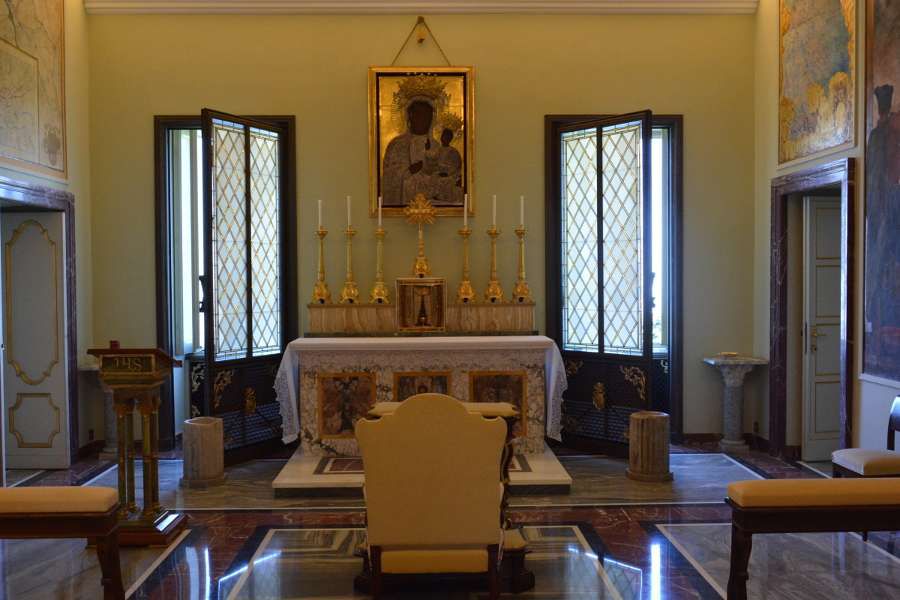Castel Gandolfo, Italy, Oct 22, 2016 / 12:04 pm (CNA/EWTN News).- Used for centuries as a private summer residence for Popes, the Apostolic Palace in Castel Gandolfo has now been opened to the public. Visitors may access rooms where Popes have died and where some 50 babies were born during the Second World War.
“Whoever crosses the threshold of the Apostolic Palace of Castel Gandolfo will encounter pure beauty,” Director of the Vatican Museums Antonio Paolucci said in an Oct. 21 statement. “Reaching the great terrace they will see below the blue eye of the lake and the mountains covered with intact forests that surround it,” he said. “Crossing the room of the Apostolic Apartment they will hear the buzz of history and think of the emotion and wonder, but also of the gratitude that each visitor will have for this unexpected gift from the Pope.”
Tours of the Pontifical Villa are being managed by the Vatican Museums. Castel Gandolfo was opened to the public Oct. 22, with tickets available for purchase on the museums’ website. The gardens of the papal residence, called the Barberini Gardens, were opened to the public in 2014 as a way to increase revenue for the town, which thrived on tourism brought by visitors who had come to see the Pope during his stay.
For Benedict XVI, the villa was a favorite summer getaway during his pontificate. It was conceded to the Holy See as one of their extraterritorial possessions under the Lateran Pact of 1929. Following major restoration efforts, the villa has served as the papal summer residence since the pontificate of Urban VIII during the 17th century. It has a small farm created by Pope Pius XI, which produces eggs, milk, oil, vegetables and honey either for local employees, or for sale in the Vatican supermarket.
Popes up until Benedict XVI used the residence as a summer getaway. However, it has been empty since the election of Pope Francis, who prefers to spend his summers in Rome. The residence was officially presented to journalists Oct. 21, in the company of Antonio Paolucci, the Director of the Pontifical Villa Osvaldo Gianoli, and the Curator of the Historical Collections of the Vatican Museums Sandro Barbagallo.
Tours of the papal residence, set to coincide with the opening and closing hours of the Apostolic Palace itself, includes a visit to the Swiss Hall where the Pope’s personal guards, the Swiss Guard, kept watch round the clock. Other stops include the Throne Room, the Consistory Hall, the Bedroom of the Holy Father and Library, the Private Study and its attached private chapel. It was inside the private chapel of Castel Gandolfo that Pope Francis and Benedict XVI prayed together shortly after Francis was elected following Benedict’s historic resignation in 2013. It marked the first time a Pope and his successor had ever prayed together.
Also noteworthy is the fact that at least for a few months during the Second World War, the papal residence in the town was used as a both a shelter for refugees and a neonatal unit. After Italy was occupied by Nazi forces in January 1944, the area around Castel Gandolfo quickly became the scene of some of the bloodiest fighting during the war. Thousands of people were displaced overnight and forced to become refugees.
Pope Pius XII, who was reigning at the time, was largely confined within the Vatican walls, in large part out of fear that he would be arrested by Nazi forces should he leave. When his secretary Msgr. Giovanni Battista Montini, the future Pope Paul VI, informed him what was happening around Castel Gandolfo, the Pope immediately ordered that the palace be made available to whoever wanted to come.
The doors were opened to the public Jan. 22, 1944. It soon filled up, eventually hosting some 12,000 people with no inquiry into their political affiliation or request for a baptismal certificate. Many Jews from Rome were among those accommodated. During the four months the Villa served as a shelter, the Pope’s own bedroom was reserved for women in labor. Some 50 babies were born inside the room, and as a result were called “the Pope’s children.” Popes have also died in the papal bedroom at Castel Gandolfo. Pius XII himself died there in 1958, as did Pope Paul VI two decades later.

